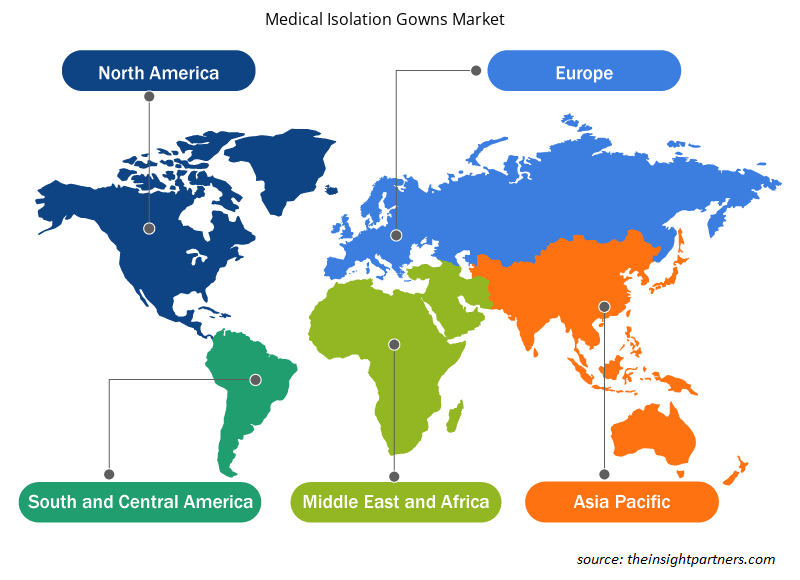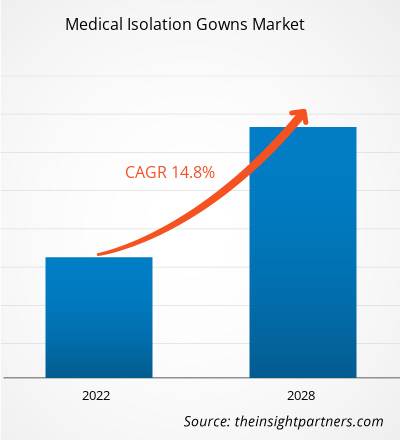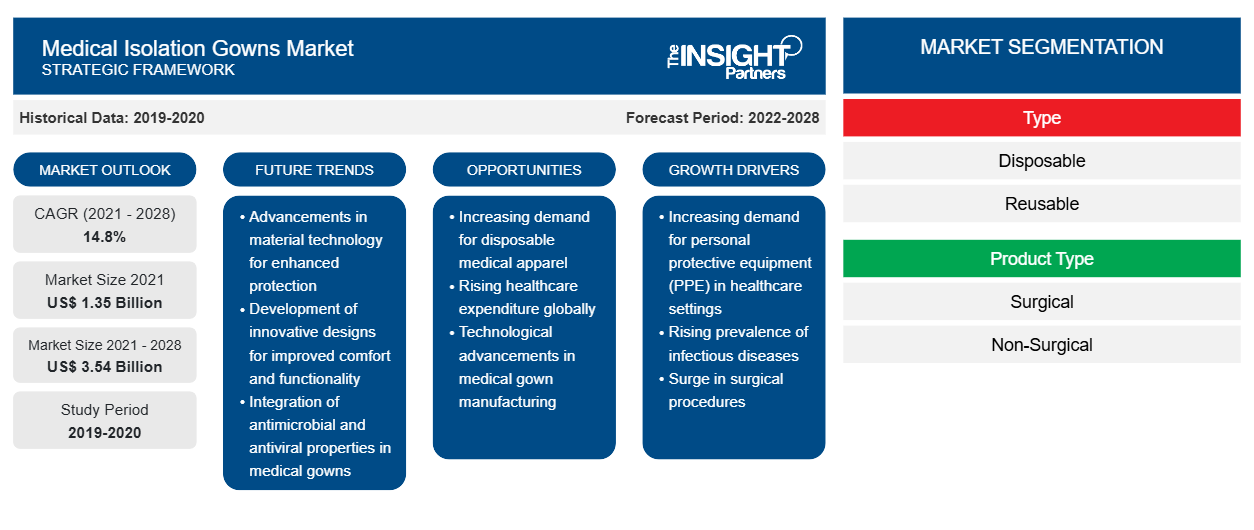Le marché des blouses d'isolement médical devrait atteindre 3 542,78 millions USD d'ici 2028, contre 1 346,31 millions USD en 2021 ; il devrait croître à un TCAC de 14,8 % de 2021 à 2028.
Le rapport offre des informations et une analyse approfondie du marché des blouses d'isolement médical en mettant l'accent sur divers paramètres, tels que les tendances et les opportunités du marché, la dynamique du marché et l'analyse du paysage concurrentiel des principaux acteurs du marché en Amérique du Nord, en Europe, en Asie-Pacifique, en Amérique du Sud et centrale et au Moyen-Orient et en Afrique. Il comprend également l'analyse de l'impact de la pandémie de COVID-19 dans les régions.
Personnalisez ce rapport en fonction de vos besoins
Vous bénéficierez d'une personnalisation gratuite de n'importe quel rapport, y compris de certaines parties de ce rapport, d'une analyse au niveau des pays, d'un pack de données Excel, ainsi que de superbes offres et réductions pour les start-ups et les universités.
- Obtenez les principales tendances clés du marché de ce rapport.Cet échantillon GRATUIT comprendra une analyse de données, allant des tendances du marché aux estimations et prévisions.
Informations sur le marché
Sensibilisation accrue aux infections contractées à l’hôpital
Les patients contractent des infections nosocomiales ou infections associées aux soins (IAS) lorsqu'ils reçoivent des services de santé dans un hôpital ou tout autre établissement de santé. Des agents pathogènes courants, tels que des bactéries, des virus, des champignons et des parasites, sont à l'origine de ces infections. Les IAS comprennent les infections urinaires associées aux cathéters, les infections du site chirurgical (ISO), les infections sanguines associées aux cathéters centraux, la pneumonie associée au respirateur, la pneumonie nosocomiale et plusieurs autres infections. De nombreux dispositifs chirurgicaux peuvent également servir de vecteurs d'IAS.
Les infections nosocomiales ont un taux de morbidité et de mortalité élevé et coûtent des milliards de dollars au système de santé chaque année. Les Centers for Disease Control (CDC) ont signalé que les infections nosocomiales sont responsables d'environ 1,7 million de cas d'infection et de 99 000 décès chaque année dans les hôpitaux américains. Le port de blouses d'isolement est obligatoire lors de toute procédure médicale dans les établissements de santé. Elles aident à prévenir la contamination croisée, le transfert de liquides corporels et tout micro-organisme responsable d'infections ainsi que la pénétration de liquides. Les agences gouvernementales, telles que le National Healthcare Safety Network (NHSN) du Center for Disease Control and Prevention (CDC), surveillent de près les infections qui aident à prévenir les infections nosocomiales et à améliorer la sécurité des patients. Aux États-Unis, le ministère de la Santé et des Services sociaux (HHS) s'efforce de réduire les cas d'infections nosocomiales. De plus, en Europe, le Healthcare-Associated Infections Surveillance Network (HAI-Net) surveille ces infections dans la région, et le fonctionnement du HAI-NET est géré et contrôlé par le Centre européen de prévention et de contrôle des maladies (ECDC). Par exemple, une enquête intitulée « Sensibilisation aux IASS parmi les étudiants en médecine dans un centre de soins tertiaires » a révélé qu’un total de 82 % (sur 250) des étudiants étaient conscients des IASS.
Informations basées sur les types
En fonction du type, le marché des blouses d'isolement médical est divisé en jetables et réutilisables. Le segment jetable détenait une part plus importante du marché en 2021. Cependant, le segment réutilisable devrait enregistrer un TCAC plus élevé de 15,5 % sur le marché au cours de la période de prévision.
Informations basées sur le type de produit
En fonction du type de produit, le marché des blouses d'isolement médical est divisé en deux catégories : chirurgicales et non chirurgicales. Le segment chirurgical détenait une part de marché plus importante en 2021. Cependant, le segment non chirurgical devrait enregistrer un TCAC plus élevé de 15,1 % au cours de la période de prévision.
Les stratégies inorganiques, telles que les fusions et acquisitions, sont couramment adoptées par les entreprises pour répondre aux demandes changeantes des clients et maintenir leur marque à travers le monde. Les acteurs opérant sur le marché des blouses d'isolement médical adoptent également des stratégies organiques, telles que le lancement et l'expansion de produits, pour étendre leur empreinte et leur portefeuille de produits dans le monde entier ainsi que pour répondre à la demande croissante.
Aperçu régional du marché des blouses d'isolement médicales
Les tendances et facteurs régionaux influençant le marché des blouses d’isolement médicales tout au long de la période de prévision ont été expliqués en détail par les analystes d’Insight Partners. Cette section traite également des segments et de la géographie du marché des blouses d’isolement médicales en Amérique du Nord, en Europe, en Asie-Pacifique, au Moyen-Orient et en Afrique, ainsi qu’en Amérique du Sud et en Amérique centrale.

- Obtenez les données régionales spécifiques au marché des blouses d'isolement médicales
Portée du rapport sur le marché des blouses d'isolement médicales
| Attribut de rapport | Détails |
|---|---|
| Taille du marché en 2021 | 1,35 milliard de dollars américains |
| Taille du marché d'ici 2028 | 3,54 milliards de dollars américains |
| Taux de croissance annuel moyen mondial (2021-2028) | 14,8% |
| Données historiques | 2019-2020 |
| Période de prévision | 2022-2028 |
| Segments couverts | Par type
|
| Régions et pays couverts | Amérique du Nord
|
| Leaders du marché et profils d'entreprises clés |
|
Densité des acteurs du marché des blouses d'isolement médical : comprendre son impact sur la dynamique commerciale
Le marché des blouses d'isolement médicales connaît une croissance rapide, tirée par la demande croissante des utilisateurs finaux en raison de facteurs tels que l'évolution des préférences des consommateurs, les avancées technologiques et une plus grande sensibilisation aux avantages du produit. À mesure que la demande augmente, les entreprises élargissent leurs offres, innovent pour répondre aux besoins des consommateurs et capitalisent sur les tendances émergentes, ce qui alimente davantage la croissance du marché.
La densité des acteurs du marché fait référence à la répartition des entreprises ou des sociétés opérant sur un marché ou un secteur particulier. Elle indique le nombre de concurrents (acteurs du marché) présents sur un marché donné par rapport à sa taille ou à sa valeur marchande totale.
Les principales entreprises opérant sur le marché des blouses d'isolement médicales sont :
- Cardinal Santé, Inc.
- Medline Industries, Inc.
- Produits de santé Leboo Limitée
- Narang Médical Limitée
- Société médicale de Shanghai
Avis de non-responsabilité : les sociétés répertoriées ci-dessus ne sont pas classées dans un ordre particulier.

- Obtenez un aperçu des principaux acteurs du marché des blouses d'isolement médicales
Par type
- Jetable
- Réutilisable
Par type de produit
- Chirurgical
- Non chirurgical
Par utilisateur final
- Hôpitaux
- Centres de chirurgie ambulatoire
- Cliniques
- Autres
Par géographie
- Amérique du Nord
- NOUS
- Canada
- Mexique
- Europe
- Serbie
- ROYAUME-UNI
- Russie
- Pologne
- Estonie
- Lituanie
- Suède
- Slovaquie
- Finlande
- Allemagne
- France
- Italie
- Espagne
- Reste de l'Europe
- Asie-Pacifique
- Chine
- Japon
- Inde
- Australie
- Corée du Sud
- Reste de l'Asie-Pacifique
- Moyen-Orient et Afrique
- Émirats arabes unis
- Arabie Saoudite
- Afrique
- Reste du Moyen-Orient et de l'Afrique
- Amérique du Sud et Amérique centrale
- Brésil
- Argentine
- Reste de l'Amérique du Sud et de l'Amérique centrale
Profils d'entreprise
- Cardinal Santé, Inc.
- Medline Industries, LP
- Produits de santé Leboo Limitée
- Narang Médical Limitée
- Société médicale de Shanghai
- Mölnlycke Health Care AB
- Soins de santé Advin
- Dispotech S.r.L.
- Standard Textile Co., Inc.
- PRIONTEX
- Sara Healthcare Pvt. Ltd.
- Analyse historique (2 ans), année de base, prévision (7 ans) avec TCAC
- Analyse PEST et SWOT
- Taille du marché Valeur / Volume - Mondial, Régional, Pays
- Industrie et paysage concurrentiel
- Ensemble de données Excel
Rapports récents
Rapports connexes
Témoignages
Raison d'acheter
- Prise de décision éclairée
- Compréhension de la dynamique du marché
- Analyse concurrentielle
- Connaissances clients
- Prévisions de marché
- Atténuation des risques
- Planification stratégique
- Justification des investissements
- Identification des marchés émergents
- Amélioration des stratégies marketing
- Amélioration de l'efficacité opérationnelle
- Alignement sur les tendances réglementaires























 Obtenez un échantillon gratuit pour - Marché des blouses d'isolement médicales
Obtenez un échantillon gratuit pour - Marché des blouses d'isolement médicales